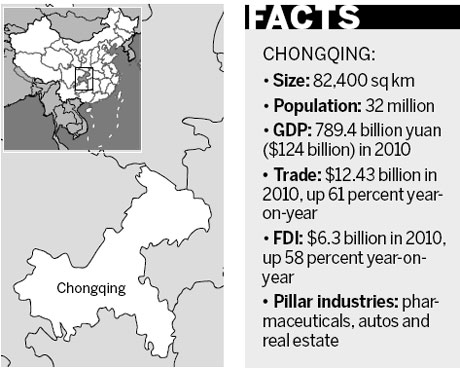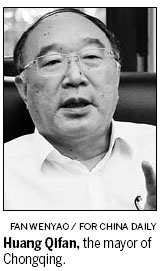Meet the man who is driving Chongqing

CHONGQING - Huang Qifan, the mayor of Chongqing, said that the government's go-west strategy has brought enormous benefits to the western part of China over the past 10 years.
The 59-year-old said he believed the program had built the platform for a rebalancing of the Chinese economy, with the west also beginning to enjoy the higher standard of living prevalent in the east of the country.
He cited Chongqing's GDP, which will increase from 100 billion yuan ($15.7 billion) at the turn of the century to an estimated 960 billion yuan this year.
"Because of this strategy, the gap between the economic level of the east and the west has quickly reduced. Over the past 10 years, the growth rate in the western part of China has been much faster than the east," he said.
The mayor said the landscape of Chongqing, in particular, has been transformed.
"Ten years ago there were only 100 kilometers of railways, now there are 1,500 km. In terms of expressways, there were only 100 km, now there are 2,000 km of expressways and highways," he said.
Huang, who has a dry sense of humor and a penchant for cigars, officially became mayor last year after a brief period as acting mayor. He had played an influential role in the development of the municipality as vice-mayor since 2001.
He is one of the few political figures in China to have had played a significant role in the development of both the east and west of the country.
|
|
Before arriving in Chongqing, he had a long career working in the local government of Shanghai, culminating in being deputy secretary-general of Shanghai municipal government and director of its economic committee.
He said the setting up of economic zones in eastern cities such as Shanghai after China's reform and opening-up in the late 1970s is very different from the current go-west campaign.
"We cannot just copy the coastal area of China in terms of the growth model. We need to create a new path of growth in line with our own conditions," he said.
One major difference is establishing industries that can manufacture their own components locally, instead of importing them from overseas.
"We are 2,000 km away from the coast, so there are heavy logistics costs if we want to bring in raw materials and components from overseas," he said.
One of the major successes has been bringing in companies such as Hewlett-Packard Co, which manufactures its components in the area.
"We recently started a project producing 100 million computers and we made a decision that 80 percent of the components of these computers would be made locally and then the products would be sold to overseas markets," he said.
"We call it vertical integration, where we produce parts and components and prepare raw materials locally. This model is quite suitable to Chongqing's own conditions."
Huang, who is from East China's Zhejiang province and who started work in a Shanghai coking plant in the 1960s before moving to local government, is renowned for his prodigious recall of statistics, which he constantly reels off at will.
He is keen to tackle head on suggestions that the go-west strategy has achieved its successes by building infrastructure at the expense of racking up local government debt.
"In terms of rating, I think the level of debt of Chongqing can be said to be triple A," he said.
Chongqing's debt of 180 billion yuan to a GDP of 960 billion yuan gives it a debt-to-GDP ratio of around only 20 percent, he said.
Huang said one of the great legacies of go-west will be Chongqing becoming the central point of a new "silk route" to Europe.
Goods are currently transported to the city and carried by railway to Xinjiang and then through Kazakhstan, Russia, Poland and Belarus into western Europe because of a new customs agreement with the European Union.
The city will become a major "inland port" and will no longer be reliant on transporting goods to the south of the country to be shipped overseas.
The mayor said that driving domestic demand in West China will be a key part of the success of the go-west strategy over the next 10 years.
"The growth model of Chongqing is in a transitional period. In the past we were seeing 70 percent of the growth of Chongqing coming from investment and 30 percent from exports, with domestic demand only having a marginal effect," he said.
"In our vision of the next five years, domestic demand will contribute 50 percent, investment 30 percent and exports just 20 percent."
China Daily



















